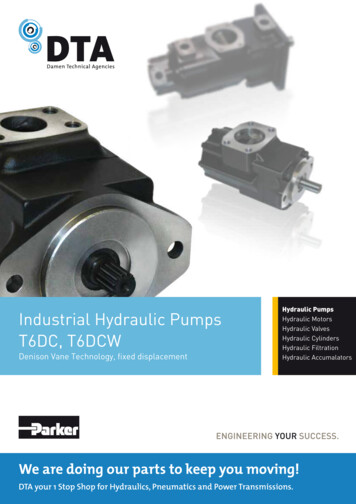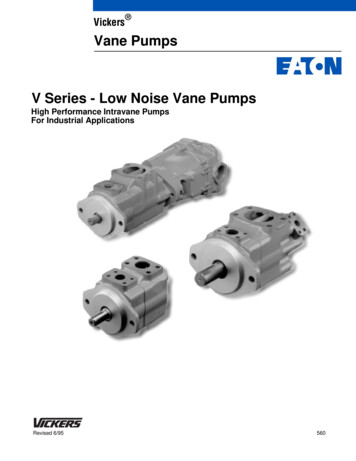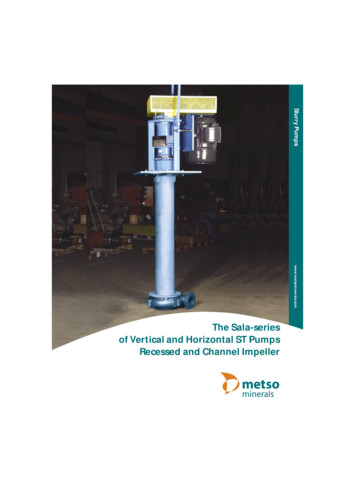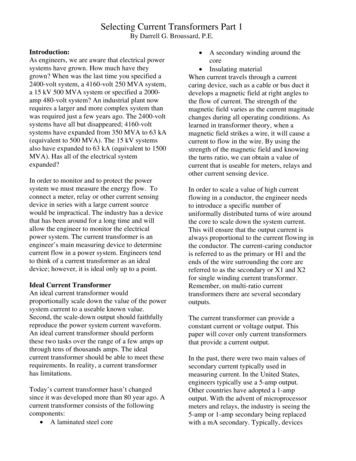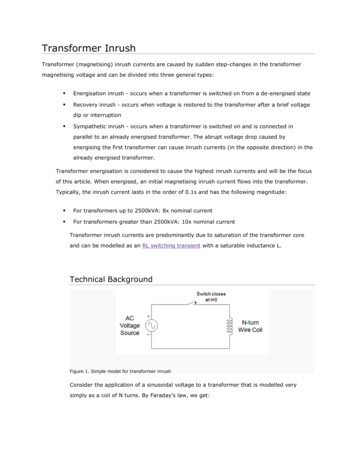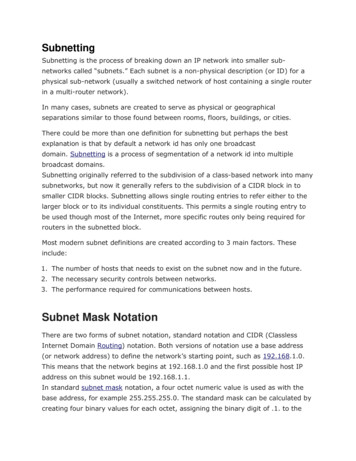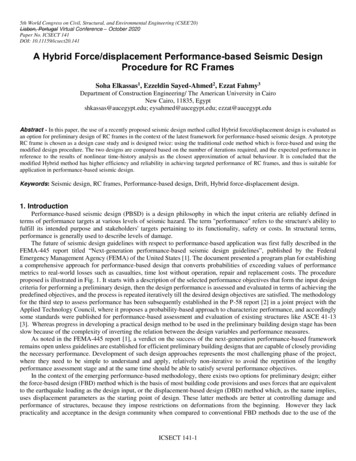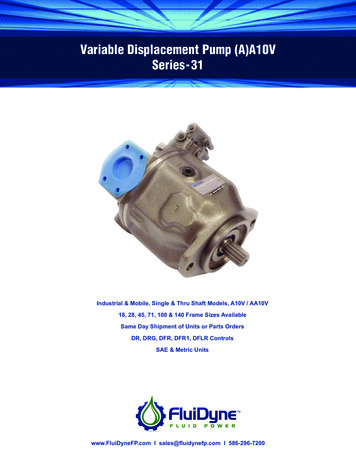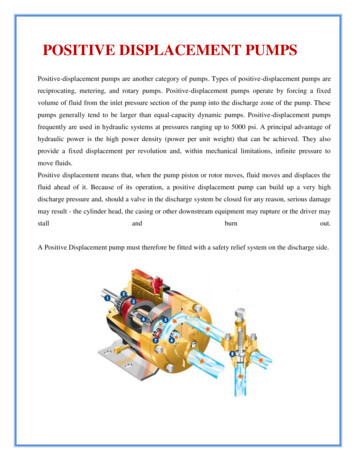
Transcription
POSITIVE DISPLACEMENT PUMPSPositive-displacement pumps are another category of pumps. Types of positive-displacement pumps arereciprocating, metering, and rotary pumps. Positive-displacement pumps operate by forcing a fixedvolume of fluid from the inlet pressure section of the pump into the discharge zone of the pump. Thesepumps generally tend to be larger than equal-capacity dynamic pumps. Positive-displacement pumpsfrequently are used in hydraulic systems at pressures ranging up to 5000 psi. A principal advantage ofhydraulic power is the high power density (power per unit weight) that can be achieved. They alsoprovide a fixed displacement per revolution and, within mechanical limitations, infinite pressure tomove fluids.Positive displacement means that, when the pump piston or rotor moves, fluid moves and displaces thefluid ahead of it. Because of its operation, a positive displacement pump can build up a very highdischarge pressure and, should a valve in the discharge system be closed for any reason, serious damagemay result - the cylinder head, the casing or other downstream equipment may rupture or the driver maystallandburnout.A Positive Displacement pump must therefore be fitted with a safety relief system on the discharge side.
TYPES OF POSITIVE DISPLACEMENT PUMPROTARY PUMPSRECIPROCATING ( PISTON ) PUMPSRotary PumpsIn Rotary pumps, movement of liquid is achieved by mechanical displacement of liquid produced byrotation of a sealed arrangement of intermeshing rotating parts within the pump casing.THE GEAR PUMPConstruction and Operation:In this pump, intermeshing gears or rotors, rotate in opposite directions, just like the gears in a vehicle ora watch mechanism. The pump rotors are housed in the casing or stator with a very small clearancebetween them and the casing. (The fluid being pumped will lubricate this small clearance and helpprevent friction and therefore wear of the rotors and casing).1. In this type of pump, only one of the rotors is driven. The intermeshing gears rotate the otherrotor. As the rotors rotate, the liquid or gas, (this type of machine can also be used as acompressor), enters from the suction line and fills the spaces between the teeth of the gears andbecomes trapped forming small 'Slugs' of fluid between the teeth.2. The slugs are then carried round by the rotation of the teeth to the discharge side of the pump.3. At this point, the gears mesh together and, as they do so, the fluid is displaced from each cavityby the intermeshing teeth.4. Since the fluid cannot pass the points of near contact of the intermeshed teeth nor between theteeth and casing, it can only pass into the discharge line.5. As the rotation continues, the teeth at the suction end are opened up again and the same amountof fluid will fill the spaces and the process repeated. The liquid at the discharge end is constantlybeing displaced (moved forward).Thus gear pumps compel or force a fixed volume of fluid to be displaced for each revolution of therotors giving the 'Positive Displacement' action of the pump.Gear pumps are generally operated at high speed and thus give a fairly pulse-free discharge flow andpressure. Where these pumps are operated at slower speeds, as in pumping viscous liquids, theoutput tends to pulsate due to the meshing of the teeth.Any gas or air drawn into the pump with the liquid, will be carried through with the liquid and will
not cause cavitation. This action of the pump means that it's a 'Self Priming' pump. The dischargepressure may however, fluctuate.The output from this type of pump is directly proportional to the speed of operation. If the speed isdoubled, the output will be doubled and the pressure will have very little effect. (At higher pressures,due to the fine clearances between the teeth and between the casing and the rotors, a small leakage backto the suction side will occur resulting in a very small drop in actual flow rate. The higher the willoccur).Rotary pumps are widely used for viscous liquids and are self-lubricating by the fluid being pumped.This means that an external source of lubrication cannot be used as it would contaminate the fluid beingpumped. However, if a rotary pump is used for dirty liquids or slurries, solid particles can get betweenthe small clearances and cause wear of the teeth and casing. This will result in loss of efficiency andexpensive repair or replacement of the pump.
Reciprocating PumpsIn a reciprocating pump, a volume of liquid is drawn into the cylinder through the suction valve on theintake stroke and is discharged under positive pressure through the outlet valves on the discharge stroke.The discharge from a reciprocating pump is pulsating and changes changes only when the speed of thepump is changed. This is because the intake is always a constant volume. Often an air chamber isconnected on the discharge side of the pump to provide a more even flow by evening out the pressuresurges. Reciprocating pumps are often used for sludge and slurry.One construction style of a reciprocating pump is the direct-acting steam pump. These consist of asteam cylinder end in line with a liquid cylinder end, with a straight rod conection between the steam
piston and the pump piston or plunger. These pistons are double acting which means that each sidepumps on every stroke.Another construction style is the power pump which convert rotary motion to low speed reciprocatingmotio using a speed reducing gear. The power pump can be either single or double-acting. A singleacting design discharges liquid only on one side of the piston or plunger. Only one suction and onedischarge stroke per revolution of the crankshaft can occur. The double-acting design takes suction anddischarges on both sides of the piston resulting in two suctions and discharges per crankshaft revolution.Power pumps are generally very efficient and can develop high pressures. These pumps do however tendto be orwards'.A 'Reciprocating' pump therefore, is one with a forward and backward operating action.The most simple reciprocating pump is the 'Bicycle Pump', which everyone at some time or other willhave used to re-inflate their bike tyres. The name 'Bicycle PUMP' is not really the correct term becauseitcausesSOurce : ion.
A 'Reciprocating' pump therefore, is one with a forward and backward operating action. The most simple reciprocating pump is the 'Bicycle Pump', which everyone at some time or other will have used to re-inflate their bike tyres. The name 'Bicycle PUMP' is not really the correct term because it
